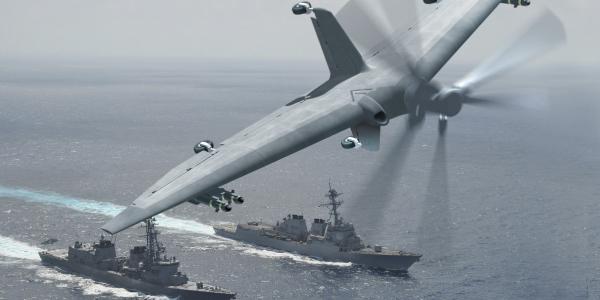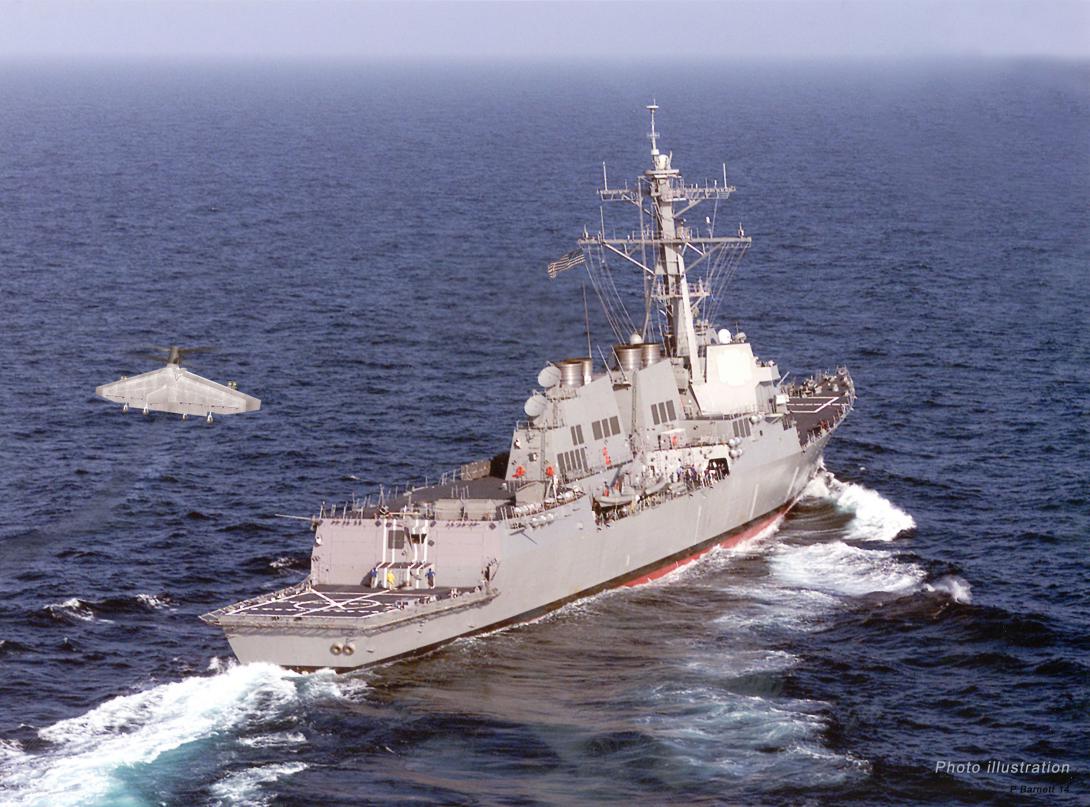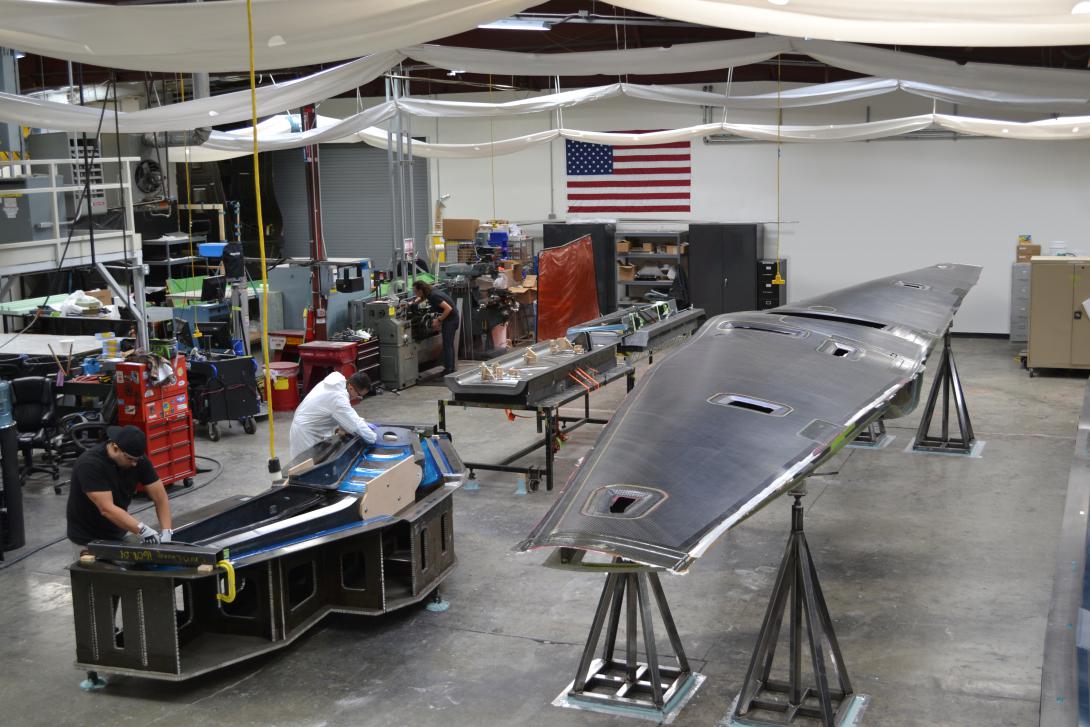Navy Turns to Tern to Make Every Ship an Aircraft Carrier
In the next few years, the U.S. Navy may finally realize a dream it has had since World War II: the ability to vertically launch and recover a fixed-wing aircraft from a ship deck. A prototype unmanned aerial system is now capable of hovering and launching vertically with a pair of nose-mounted, counter-rotating propellers, and then transitioning to high-speed horizontal flight as the propellers shift to propulsion mode and push air over its large fixed-wing surfaces. If the aircraft becomes operational, it will provide Navy ships a long-range, high-endurance surveillance and strike platform—something smaller surface units lack, absent an aircraft carrier or an amphibious assault ship.
At first glance, the Tactically Exploited Reconnaissance Node, or Tern, unmanned aerial system (UAS) looks like an aircraft sitting on its tail. In fact, it is. Developed by the Defense Advanced Research Projects Agency (DARPA), the Office of Naval Research (ONR) and Northrop Grumman, Tern bears a strong resemblance to several experimental Navy aircraft from the 1950s, specifically, the Convair XFY-1 Pogo and the Lockheed XFV.
Both aircraft were part of a program to develop fighter planes that could launch and land vertically from a ship’s deck to greatly expand the fleet’s air operations capabilities. Given the available technology, the aircraft required pilots and were deemed potentially too dangerous and difficult to land on the moving deck of a ship in high seas. As a result, the need remained for long-range reconnaissance and surveillance missions beyond the range of shipboard helicopters.
Enter Tern. The UAS demonstrates not only the capability to launch and land from a Navy destroyer or a littoral combat ship but also a medium-altitude, long-endurance capability on par with that of Reaper and Predator unmanned aircraft.
“That was really what we were looking to do—to put that sort of runway-independent capability in an apparatus and enable launch and recovery from small helicopter flight decks,” explains Graham Drozeski, Tern’s program manager at DARPA. He adds that the Marine Corps also is interested in the aircraft because of its vertical launch capability.
Designed by Northrop Grumman, Tern has wings and stubby vertical stabilizers with integrated landing gear at the edges of the wings and control surfaces. A variant of the General Electric T700 turboshaft engine used in a variety of helicopters and fixed-wing aircraft provides the power.
At takeoff, the propellers act as helicopter rotors, with control movements in vertical mode using cyclic, collective and differential collective control modes similar to those in helicopters, Drozeski says. Once the aircraft is away from the ship’s deck, it transitions to horizontal flight.
Unlike its 1950s predecessors, Tern uses a radar-based, automated landing system with technology Northrop Grumman developed for the Fire Scout autonomous helicopter. The onboard navigation system measures the relative motion of the ship’s deck in respect to the aircraft and then generates flight commands to bring the UAS down to a smooth landing, Drozeski explains.
In addition to its vertical takeoff and landing capabilities, the aircraft could extend a warship’s situational awareness. For intelligence, surveillance and reconnaissance (ISR) and potential strike missions, the goal is to have a platform with a minimum range of 600 nautical miles and a minimum payload of 500 pounds.
Another goal is for a ship operating two or more Terns to be able to maintain a continuous ISR presence within the 600-mile operational radius for up to 10 days. Although Drozeski cannot provide details, he notes that the aircraft’s operational endurance will be comparable to Predator and Reaper, which can remain airborne for more than 12 hours.
Tern’s size suits ships. The aircraft fits easily in the helicopter hangars aboard destroyers, frigates and littoral combat ships, Drozeski relates. DARPA and Northrop Grumman engineers have studied how it will be moved into and out of a ship’s hangar, how it will be folded to fit inside the hangar and how it will be stowed.
For ease of operation, Tern runs on standard Navy aviation fuels such as JP-5, JP-8 and Jet-A, he notes. The aircraft also borrows some autonomous handling characteristics developed for the Fire Scout for launch and recovery operations; minimal assistance from the ship’s aviation detachment is required.
Although the UAS program does not focus on next-generation autonomous technologies, the framework of Tern’s control and maintenance systems permits adding systems as they become available.
Launched in 2013, the program is now in its third phase, with two prototypes under construction for flight tests early next year, Drozeski says. DARPA will conduct integrated tests of the aircraft’s propulsion system, putting a full-scale engine, gearbox and rotors through full power and rotation assessments.
Construction began on major airframe components earlier this year, and at least one demonstrator aircraft may be completed by year’s end. The second and third phases of the Tern program focused on engine tests, with the modified T700 engine successfully transitioning and operating in both vertical and horizontal orientations.
Software integration tests concluded last year, DARPA officials note. High-fidelity simulation tools were used to test Tern’s flight-control software in all phases of flight.
Initial flight tests will take place on land and, if successful, transition to at-sea demonstrations of takeoff, transition to and from horizontal flight, and landing. The tests will occur on a deck about the size of those on destroyers or small combat ships, and either an active-duty warship or a vessel fitted with a test-landing deck will play host.







Comments